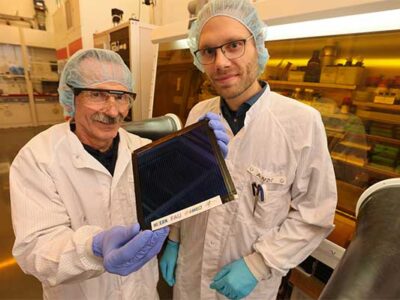Singlet fission, in which an initially excited singlet state spontaneously splits into a pair of triplet excitons, is a process that can potentially boost the efficiency of solar energy conversion.
This is the main subject of a research article “Singlet Fission: From Coherences to Kinetics” published by chemists at the University of California, Riverside in the Journal Physical Chemistry Letters.
The article discusses their work on “singlet fission”–a process they are confident can boost solar cell efficiency by as high as 30%.
That’s all great–but what do we understand by the process of ‘Singlet fission’?
Chemists that specialize in spectroscopy explain that singlet fission is simply the production of two triplet excitons from the absorption of a single photon.
It is a spin-allowed process whereby a singlet excited state converts to two triplet states. This mostly occurs in molecular crystals where the crystals are specifically oriented such that one excited molecule tends to distribute or share energy with a near-by ground state or unexcited molecule.
An earlier publication in the journal Nature titled ‘Harvesting singlet fission for solar energy conversion via triplet energy transfer‘ by John R. Tritsch and his colleagues had suggested that the efficiency of organic photovoltaic materials could be enhanced if one incorporates a molecular material capable of singlet fission in them.
“If a triplet exciton has half the energy of a singlet, then it is possible for one singlet exciton, generated by one photon, to split into two triplet excitons,” said Christopher Bardeen, a professor of chemistry, whose lab led the research. “Thus, you could have a 200% yield of excitons — and hopefully, electrons — per absorbed photon.”
The separate electronic bands in organic semiconductors make them especially useful for dividing a high-energy singlet exciton into a pair of lower-energy triplet excitons.
“To absorb a photon, the photon energy has to be greater than the bandgap of the semiconductor, so you already miss part of the solar spectrum,” Bardeen said. “But if you absorb a photon with energy higher than the bandgap, it has too much energy, and that excess energy is usually wasted as heat. The trick is to take that high energy exciton and split the energy into two excitons, rather than dissipating it as heat.”
Next step?
The research concludes that–recent experiments illustrate the role of spin coherence in fission, while kinetic models are used to describe how triplet and singlet states interact on longer time scales. Despite insights gained from recent experiments, the detailed structure and dynamics of the electronic states involved in the initial step of singlet fission remain active areas of investigation.
On longer time scales, finding ways to efficiently harvest the triplet excitons will be an important challenge for making devices based on this phenomenon. A full understanding of singlet fission requires consideration of a sequence of photophysical events (decoherence, relaxation, and diffusion) occurring on different time scales.
PV-Buzz will continue to update you on this story as it develops.















Comments